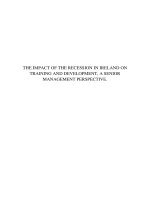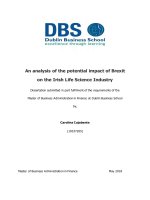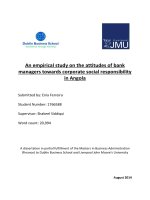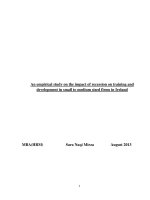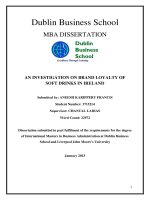Master Thesis in Economics: Manufacturing Engineers’ Understanding On The Value Of Risk Management To Project Success In The Pharmaceutical Industry
Bạn đang xem bản rút gọn của tài liệu. Xem và tải ngay bản đầy đủ của tài liệu tại đây (1.42 MB, 158 trang )
MANUFACTURING ENGINEERS’
UNDERSTANDING ON THE
VALUE OF RISK MANAGEMENT
TO PROJECT SUCCESS IN THE
PHARMACEUTICAL INDUSTRY
OF IRELAND.
Jean Livingston
1765620 MBA Project Management
MANUFACTURING ENGINEERS’ UNDERSTANDING ON THE VALUE OF
RISK MANAGEMENT TO PROJECT SUCCESS IN THE
PHARMACEUTICAL INDUSTRY OF IRELAND.
Manufacturing engineer’s understanding on the value of risk management to
project success in the pharmaceutical industry of Ireland.
Dublin Business School/Liverpool John Moore’s
University
Dissertation submitted in part fulfilment of the requirement for the degree of Master’s
in Business Administration (MBA) at Liverpool John Moore’s University in
conjunction with Dublin Business School.
Jean Livingston
Student number:
1765620
16 August 2013
Word Count: 20,920 words
Page 1 of 157
MANUFACTURING ENGINEERS’ UNDERSTANDING ON THE VALUE OF
RISK MANAGEMENT TO PROJECT SUCCESS IN THE
PHARMACEUTICAL INDUSTRY OF IRELAND.
Table of Contents
Declaration ..................................................................................................................... 9
Acknowledgement ....................................................................................................... 10
Abstract ........................................................................................................................ 11
Chapter 1 – Introduction .............................................................................................. 13
1.1
Research Area ............................................................................................... 15
1.2
Research Objectives ...................................................................................... 15
1.3
Research Questions ....................................................................................... 17
1.4
Research Hypothesis ..................................................................................... 19
1.5
Researcher Suitability ................................................................................... 21
1.6
Recipient of Research.................................................................................... 21
1.7
Research Limitations ..................................................................................... 22
1.8
Organisation of Dissertation.......................................................................... 23
Chapter 2 – Literature Review ..................................................................................... 26
Background of Literature Review ............................................................................ 26
2.1 Pharmaceutical Industry..................................................................................... 28
2.2 Project Success................................................................................................... 32
2.3 Risk Management .............................................................................................. 36
2.3.1 Risk Identification ....................................................................................... 38
2.3.2 Risk Analysis .............................................................................................. 43
Page 2 of 157
MANUFACTURING ENGINEERS’ UNDERSTANDING ON THE VALUE OF
RISK MANAGEMENT TO PROJECT SUCCESS IN THE
PHARMACEUTICAL INDUSTRY OF IRELAND.
2.3.3 Risk Response ............................................................................................. 48
Chapter 3 – Research Methodology............................................................................. 54
3.1 Introduction ........................................................................................................ 54
3.2 Research Methodology ...................................................................................... 55
3.3 Research Philosophy .......................................................................................... 56
3.4 Research Approach ............................................................................................ 59
3.5 Research Strategy............................................................................................... 61
3.6 Research Choice................................................................................................. 63
3.7 Time Horizons ................................................................................................... 65
3.8 Data Collection .................................................................................................. 66
3.8.1 Primary Data Collection ............................................................................. 68
3.8.2 Secondary Data Collection ......................................................................... 68
3.8.3 Techniques for Data Analysis ..................................................................... 68
3.9 Population and Sample ...................................................................................... 69
3.10 Research Ethics ................................................................................................ 74
3.11 Research Limitations ....................................................................................... 74
Chapter 4 – Data Analysis and Findings...................................................................... 77
4.1 Overview ............................................................................................................ 77
4.2 Demographic Data ............................................................................................. 78
4.3 Risk Identification .............................................................................................. 83
4.4 Risk Analysis ..................................................................................................... 91
Page 3 of 157
MANUFACTURING ENGINEERS’ UNDERSTANDING ON THE VALUE OF
RISK MANAGEMENT TO PROJECT SUCCESS IN THE
PHARMACEUTICAL INDUSTRY OF IRELAND.
4.5 Risk Response .................................................................................................... 98
4.6 Risk Management and Project Success............................................................ 105
Chapter 5 – Conclusions ............................................................................................ 107
5.1 Conclusions ...................................................................................................... 107
5.1.1 Risk Identification ..................................................................................... 108
5.1.2 Risk Analysis ............................................................................................ 109
5.1.3 Risk Response ........................................................................................... 111
5.1.4 Risk Management and Project Success ..................................................... 113
5.2 Limitations of the research............................................................................... 114
Chapter 6 – Recommendations .................................................................................. 118
Chapter 7 – Self-Reflections ...................................................................................... 121
6.1 Learning Styles ................................................................................................ 121
6.1.1. Convergers ............................................................................................... 122
6.1.2. Accommodators ....................................................................................... 123
6.1.3. Divergers .................................................................................................. 123
6.1.4. Assimilators ............................................................................................. 124
6.2 Self-Assessment ............................................................................................... 124
6.3 Future Application ........................................................................................... 128
Chapter 8 – Appendix ................................................................................................ 131
8.1 Appendix 1: Survey ......................................................................................... 131
8.2 Appendix 2: Dissertation Gantt Chart.............................................................. 138
Page 4 of 157
MANUFACTURING ENGINEERS’ UNDERSTANDING ON THE VALUE OF
RISK MANAGEMENT TO PROJECT SUCCESS IN THE
PHARMACEUTICAL INDUSTRY OF IRELAND.
8.3 Appendix 3: Frequency Tables ........................................................................ 140
Chapter 9 – Bibliography ........................................................................................... 151
Page 5 of 157
MANUFACTURING ENGINEERS’ UNDERSTANDING ON THE VALUE OF
RISK MANAGEMENT TO PROJECT SUCCESS IN THE
PHARMACEUTICAL INDUSTRY OF IRELAND.
Table of Figures
Figure 1: European Pharmaceutical Growth (MarketLine, 2012a) ............................. 29
Figure 2: Pharmaceutical Companies European Market Share (MarketLine, 2012a) . 31
Figure 3: Project Success Factors (Pinto and Slevin, 1988) ........................................ 34
Figure 4: Research Onion (Saunders, Lewis and Thornhill, 2012, p.128) .................. 56
Figure 5: Methodological Choice (Saunders, Lewis and Thornhill, 2006, p.146) ...... 64
Figure 6: Gender graph ................................................................................................ 78
Figure 7: Age Range of Respondents .......................................................................... 79
Figure 8: Length of Time in Pharmaceutical Industry ................................................. 80
Figure 9: Overseen a Project ........................................................................................ 81
Figure 10: Project Success ........................................................................................... 82
Figure 11: Identification of Risk .................................................................................. 83
Figure 12: Use of Risk Identification Techniques ....................................................... 85
Figure 13: Risk Identification Tools Future Usage...................................................... 87
Figure 14: Risk Identification Tools Ranking ............................................................. 89
Figure 15: Risk Identification Preventing Failure ....................................................... 90
Figure 16: Analysing Risks Using Statistics ................................................................ 91
Figure 17: Analysing Risks .......................................................................................... 92
Figure 18: Risk Analysis Tools Usage......................................................................... 94
Figure 19: Risk Analysis Tool Rankings ..................................................................... 96
Figure 20: Risk Analysis & Project Success................................................................ 97
Figure 21: Developed Risk Response .......................................................................... 98
Figure 22: Risk Response Usage Frequency ............................................................. 100
Figure 23: Ranking of Risk Response ....................................................................... 102
Page 6 of 157
MANUFACTURING ENGINEERS’ UNDERSTANDING ON THE VALUE OF
RISK MANAGEMENT TO PROJECT SUCCESS IN THE
PHARMACEUTICAL INDUSTRY OF IRELAND.
Figure 24: Risk Strategies Involvement ..................................................................... 103
Figure 25: Risk Strategies and Project Outcome ....................................................... 104
Figure 26: Risk Management and Project Success .................................................... 105
Figure 27: Kolb’s Learning Styles (Source: Concept David Kolb, adaptation and
design Alan Chapman (2006)) ................................................................................... 122
Page 7 of 157
MANUFACTURING ENGINEERS’ UNDERSTANDING ON THE VALUE OF
RISK MANAGEMENT TO PROJECT SUCCESS IN THE
PHARMACEUTICAL INDUSTRY OF IRELAND.
Table of Tables
Table 1: Frequency Table Question 1 ........................................................................ 140
Table 2: Frequency Table Question 2 ........................................................................ 140
Table 3: Frequency Table Question 3 ........................................................................ 140
Table 4: Frequency Table Question 4 ........................................................................ 141
Table 5: Frequency Table Question 5 ........................................................................ 141
Table 6: Frequency Table Question 6 ........................................................................ 141
Table 7: Frequency Table Question 7 ........................................................................ 142
Table 8: Frequency Table Question 8 ........................................................................ 143
Table 9: Frequency Table Question 9 ........................................................................ 144
Table 10: Frequency Table Question 10 .................................................................... 144
Table 11: Frequency Table Question 11 .................................................................... 145
Table 12: Frequency Table Question 12 .................................................................... 145
Table 13: Frequency Table Question 13 .................................................................... 146
Table 14: Frequency Table Question 14 .................................................................... 147
Table 15: Frequency Table Question 15 .................................................................... 147
Table 16: Frequency Table Question 16 .................................................................... 148
Table 17: Frequency Table Question 17 .................................................................... 148
Table 18: Frequency Table Question 18 .................................................................... 149
Table 19: Frequency Table Question 19 .................................................................... 149
Table 20: Frequency Table Question 20 .................................................................... 149
Table 21: Frequency Table Question 21 .................................................................... 149
Page 8 of 157
MANUFACTURING ENGINEERS’ UNDERSTANDING ON THE VALUE OF
RISK MANAGEMENT TO PROJECT SUCCESS IN THE
PHARMACEUTICAL INDUSTRY OF IRELAND.
Declaration
I, Jean Livingston, declare that this research report is my own, unaided work, except
as indicated in the acknowledgments, the text and the references.
This report is being submitted in partial fulfilment of the requirements for the degree
of ‘Master of Business Administration Project Management’ at Dublin Business
School, Dublin.
It has not been submitted before, in whole, or in part for any degree or examination at
any other institution.
Jean Livingston
Signed ……….………………………………… on the day of 16/08/2013.
Page 9 of 157
MANUFACTURING ENGINEERS’ UNDERSTANDING ON THE VALUE OF
RISK MANAGEMENT TO PROJECT SUCCESS IN THE
PHARMACEUTICAL INDUSTRY OF IRELAND.
Acknowledgement
The completion of this master’s dissertation owes much help, understanding and
support to many people. First I would like to thank Dublin Business School and the
Liverpool John Moore University for allowing me to undertake this master’s degree in
Project Management. This year was extremely influential and a great learning
experience for me.
I would also like to greatly thank my supervisor, Mr Patrick Mongey. Patrick made
his support available in a number of different and insightful ways. He provided me
with advice and guidance without which this dissertation would never have been
completed.
I would also like to thank my friends and family for helping me through this stressful
time and by helping me any way they could. Without their love and support this
dissertation would never have been completed.
Page 10 of 157
MANUFACTURING ENGINEERS’ UNDERSTANDING ON THE VALUE OF
RISK MANAGEMENT TO PROJECT SUCCESS IN THE
PHARMACEUTICAL INDUSTRY OF IRELAND.
Abstract
The primary objective of this study was to comprehend the understanding
manufacturing engineer’s had of the value of risk management to project success in
the pharmaceutical industry in Ireland. The adoption of manufacturing engineers to
lead projects instead of traditional project managemers has increased during the
economic downturn. Risk management has been developed over the last fifty years
and has significant impact on project success. The objective was to discover if
manufacturing engineers understood this value.
Projects have always been a critical part of the pharmaceutical industry as the
majority of its research and development is undertaken in the form of research and
development projects. This research found that it is true that engineers are taking on
more of a project management role in these pharmaceutical projects. The research
also proved that manufacturing engineers understand that risk management is
important to project success and the different stages of risk management are
individually and collectively important to project success.
Page 11 of 157
MANUFACTURING ENGINEERS’ UNDERSTANDING ON THE VALUE OF
RISK MANAGEMENT TO PROJECT SUCCESS IN THE
PHARMACEUTICAL INDUSTRY OF IRELAND.
Chapter 1
Introduction
Page 12 of 157
MANUFACTURING ENGINEERS’ UNDERSTANDING ON THE VALUE OF
RISK MANAGEMENT TO PROJECT SUCCESS IN THE
PHARMACEUTICAL INDUSTRY OF IRELAND.
Chapter 1 – Introduction
“Pharmaceutical projects are like fresh fruit – they depreciate if they are not tended to,
and they do poorly if sitting on the shelf with long periods of inactivity” (Burns,
2013). As the pharmaceutical industry in Ireland grows and leans towards an increase
in research and development projects, the need for good project management for the
pharmaceutical industry increases. The manufacturing engineers that are involved
with these projects are increasingly becoming project leaders despite having no
formal project management experience. Organisations are employing manufacturing
engineers as project managers as a cost saving measure during the economic
downturn. Organisations are not focusing on the cost of project failure in their budgets
at the early stages of the projects, which is why they are saving the cost of employing
a project manager by using an existing engineer. The majority of manufacturing
engineers in the pharmaceutical industry understand the need for proper risk
management in order to improve the likelihood of project success but they are unable
to implement correct risk management plans and procedures due to lack of formal
knowledge and training.
In response to this growing trend of employing manufacturing engineers as project
managers for costly pharmaceutical projects, it might be worthwhile for
manufacturing engineers to undergo formal project management training. A correctly
implemented risk management plan can increase project success. The importance of
risk management will be explored throughout this research project.
Page 13 of 157
MANUFACTURING ENGINEERS’ UNDERSTANDING ON THE VALUE OF
RISK MANAGEMENT TO PROJECT SUCCESS IN THE
PHARMACEUTICAL INDUSTRY OF IRELAND.
This research project explores the three main stages of the risk management process,
risk identification, risk analysis and risk response. The researcher also explores the
tools and techniques used for each of the stages of risk management to help increase
the likelihood of project success. This research project also explores the preference
that manufacturing engineers have with the common tools and techniques used in the
risk management process.
There is a large amount of literature available on project success and risk
management, including the models of the risk management process and the debate on
the definition of project success. However there is a gap in the literature which can be
the difference between understanding risk management and project success. The
majority of the literature focuses on a project managers understanding on project
success whereas there is no literature of manufacturing engineer’s ideas of project
success. The literature does not explore what tools and techniques are the most
commonly used by manufacturing engineers for each of the three stages of risk
management. There is also a literature gap when risk management is looked at for
pharmaceutical projects, especially when focusing on the pharmaceutical industry in
Ireland.
Page 14 of 157
MANUFACTURING ENGINEERS’ UNDERSTANDING ON THE VALUE OF
RISK MANAGEMENT TO PROJECT SUCCESS IN THE
PHARMACEUTICAL INDUSTRY OF IRELAND.
1.1 Research Area
How does project risk management affect project success?
Do manufacturing engineers undertake the role of project manager during
pharmaceutical projects?
What are the risk management tool that are most commonly used in the
pharmaceutical industry?
1.2 Research Objectives
Research objects are the clear and precise statements that identify what the researcher
will accomplish during his or her research project (Saunders, Lewis and Thornhill,
2012, p.32). Research objectives provide the focus and the direction for the researcher
to ensure a clear and concentrated research project.
Page 15 of 157
MANUFACTURING ENGINEERS’ UNDERSTANDING ON THE VALUE OF
RISK MANAGEMENT TO PROJECT SUCCESS IN THE
PHARMACEUTICAL INDUSTRY OF IRELAND.
The following research objectives are the objectives that are concentrated on during
this research project:
To determine the most common risk identification tool used by manufacturing
engineers and if this tool, along with the practice of risk identification helps
improve project success.
To discover if the practice of risk analysis helps improve overall project
success and to discover what is the most common risk analysis tool used in the
pharmaceutical industry.
To uncover what the most common risk response strategy used by
manufacturing engineers in the pharmaceutical industry is and if the technique
of risk response helps improves project success.
To detect the value of risk management to project success as understood by
manufacturing engineers in the pharmaceutical industry.
The research focuses on the influence risk management has on project success. The
objectives of this research are closely related to the scope of the research and
therefore no separate discussion on research scope is necessary for this research
project.
Page 16 of 157
MANUFACTURING ENGINEERS’ UNDERSTANDING ON THE VALUE OF
RISK MANAGEMENT TO PROJECT SUCCESS IN THE
PHARMACEUTICAL INDUSTRY OF IRELAND.
1.3 Research Questions
Question 1: What is the most common risk identification technique used in
pharmaceutical projects?
Rationale: The literature would suggest that either checklists or risk breakdown
structure creation are the most popular techniques in the identification of risks
(Hassanein and Afify, 2007) (Stosic, Isljamovic and Mihic, 2013) (Larson and Gray,
2011, p.214). These only apply to the construction and new product innovation and
there is no information on techniques used in the pharmaceutical industry.
Question 2: Is qualitative risk analysis more commonly used that quantitative
risk analysis?
Rationale: According to Kerzner (2013, p.766) qualitative risk analysis is the most
commonly used method, however Larson and Gray (2011, p.216) states that the most
commonly used technique is scenario analysis, which according to Rezakhani (2012)
is usually a quantitative technique.
Page 17 of 157
MANUFACTURING ENGINEERS’ UNDERSTANDING ON THE VALUE OF
RISK MANAGEMENT TO PROJECT SUCCESS IN THE
PHARMACEUTICAL INDUSTRY OF IRELAND.
Question 3: What is the most popular risk strategy used in the pharmaceutical
industry?
Rationale: According to Tworek (2012), building contractors in the United States
preferred method of risk strategy is risk retention and in Poland it is risk avoidance.
There is little evidence on which risk strategy is most commonly used in Ireland or by
the pharmaceutical industry in Ireland.
Question 4: Does risk management have any impact on the success of a project?
Rationale: According to Pretorius, Steyn and Jordaan (2012) risk management has no
impact on the outcome of a project. Conversely the PMI (2013, p.310) states that a
correctly implemented risk management policy can greatly improve the chances that a
project meets their objectives and succeeds.
Page 18 of 157
MANUFACTURING ENGINEERS’ UNDERSTANDING ON THE VALUE OF
RISK MANAGEMENT TO PROJECT SUCCESS IN THE
PHARMACEUTICAL INDUSTRY OF IRELAND.
1.4 Research Hypothesis
Hypothesis 1: The most commonly used risk identification technique used by
manufacturing engineers are checklists.
Rationale: The most commonly used technique used by contractors and civil
engineers for risk identification is the checklist (Hassanein and Afify, 2007), it is
reasonable to assume that manufacturing engineers working in the pharmaceutical
industry would also use similar techniques in their risk identification.
Hypothesis 2: Manufacturing engineers use probability and statistical analysis
which would indicate that they would use a quantitative method for risk analysis.
Rationale: According to Nicholas and Steyn (2008, p.373) engineers use statistical
and probability techniques to implement the risk analysis technique of scenario
analysis for their project.
Page 19 of 157
MANUFACTURING ENGINEERS’ UNDERSTANDING ON THE VALUE OF
RISK MANAGEMENT TO PROJECT SUCCESS IN THE
PHARMACEUTICAL INDUSTRY OF IRELAND.
Hypothesis 3: The least used strategy for risk response is the risk mitigation
strategy.
Rationale: According to Larson and Gray (2011, pp.219-220) and Melnic (2010) risk
mitigation or reduction may be expensive especially if it is required to attempt to
reduce the impact the event may have on the project. For this reason it is reasonable
that project managers might seek a less expensive risk strategy to implement.
Hypothesis 4: Correctly implemented risk management does impact on the
outcome of a project.
Rationale: Larson and Gray (2011, p.211), Lock (2008, p.99) and PMI (2013, p.310)
state that correctly implemented risk management affects the outcome of the project
in a positive way. In opposition however, Pretorius, Steyn and Jordaan (2012) state
that it does not have an impact, with the majority of the literature agreeing that it does
impact the outcome, it is reasonable to assume that manufacturing engineers will
agree.
Page 20 of 157
MANUFACTURING ENGINEERS’ UNDERSTANDING ON THE VALUE OF
RISK MANAGEMENT TO PROJECT SUCCESS IN THE
PHARMACEUTICAL INDUSTRY OF IRELAND.
1.5 Researcher Suitability
The researcher holds a degree in biomedical engineering from Dublin City University.
The researcher has successfully completed all the relevant modules in the MBA
Project Management program at Dublin Business School and will use the information
gained from these modules, especially the two project management modules: project
management tools and techniques and project management planning and control, to
aid in this research project. The researcher will also use her work experience in the
pharmaceutical industry as a backdrop to this research project.
The researcher has knowledge and enthusiasm towards project management
especially the risk management process as well as an interest in the pharmaceutical
industry, the researcher is self-assured and suitable to undertake this research project.
1.6 Recipient of Research
This research project is intended to perform a detailed investigation to understand
manufacturing engineer’s understanding on the value of the risk management process
to project success in the pharmaceutical industry in Ireland. Many of the respondents
of the self-administered web based surveys have shown interest in the results of this
research project. A copy of the results of this survey will be available to any
respondents who request the results.
Page 21 of 157
MANUFACTURING ENGINEERS’ UNDERSTANDING ON THE VALUE OF
RISK MANAGEMENT TO PROJECT SUCCESS IN THE
PHARMACEUTICAL INDUSTRY OF IRELAND.
This dissertation is submitted as part of the Masters in Business Administration
Project Management curriculum in Dublin Business School in association with
Liverpool’s John Moore University. The primary recipient of this research project is
Dublin Business School and Liverpool’s John Moore University staff and students,
especially Mr Patrick Mongey.
1.7 Research Limitations
There is a time limit placed on the research project which limits the amount of
manufacturing engineers being targeted to ninety. This is only a tiny proportion of
the sample size however this will have to be representative of the total population due
to this time limitation.
Using a quantitative method for the research project, the researcher faces many
limitations to her research this research method. The rigidity of the quantitative
method doesn’t allow for many fluctuations when applied to the social sciences.
Subjects respond based on their past experiences and the expectations that are placed
on them (Burns and Burns, 2008, p.17).
Page 22 of 157
MANUFACTURING ENGINEERS’ UNDERSTANDING ON THE VALUE OF
RISK MANAGEMENT TO PROJECT SUCCESS IN THE
PHARMACEUTICAL INDUSTRY OF IRELAND.
Another limitation with the quantitative method is that there is no definitive way in
which participants will react when asked to complete a survey. Some of the
participants might find the content boring or too personal which will limit the
response rate. To overcome this the researcher is planning to distribute between 180
and 200 surveys to possible participants. (Burns and Burns, 2008, p.17)
1.8 Organisation of Dissertation
The organisation of this dissertation is divided into nine separate chapters each
dealing with a separate area of study for this research project.
Chapter 1 is an introduction to the dissertation including several parts of the research
project including the research area, research objectives, research questions and
research hypotheses.
Chapter 2 is the literature review which contains the academic materials read and
critiqued by the researcher about this dissertation topic. The literature review chapter
is divided into four sections, the first being a brief background into why the literature
review was undertaken. The second section deals with the pharmaceutical industry in
Ireland. The third section deals with the problems surrounding defining project
success. The final section deals with the different stages of risk management; risk
identification, risk analysis and risk response and the impact that they has on project
success.
Page 23 of 157
MANUFACTURING ENGINEERS’ UNDERSTANDING ON THE VALUE OF
RISK MANAGEMENT TO PROJECT SUCCESS IN THE
PHARMACEUTICAL INDUSTRY OF IRELAND.
Chapter 3 comprises of the research methodology. This section detains how and why
the researcher is going to carry out her research project in order to obtain answers to
her research questions, determine the validity of her research hypotheses and meet her
research objectives.
Chapter 4 is the data analysis and findings section. In this section the results and
findings of the data collected are recorded on paper.
Chapter 5 contain the conclusions, which provides conclusions to her research project
and research area.
Chapter 6 are the recommendations, which provides the recommendations the
researcher has made in relation to this topic.
Chapter 7 deals with the researcher’s reflection about her experience in conducting
this research project at Dublin Business School.
Chapter 8 and 9 deal with the appendices and bibliography related to the research
undertaken for this project.
Page 24 of 157


